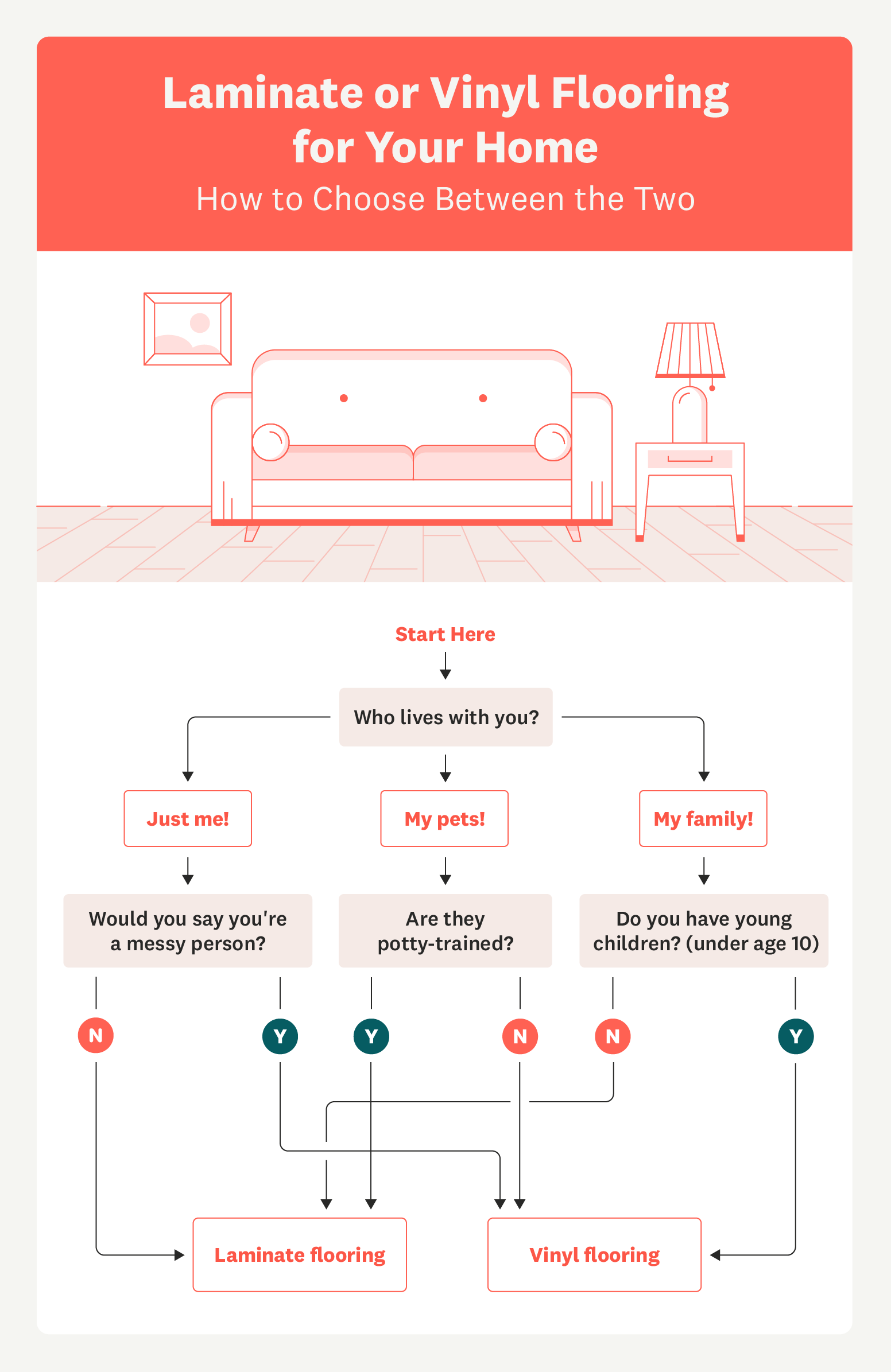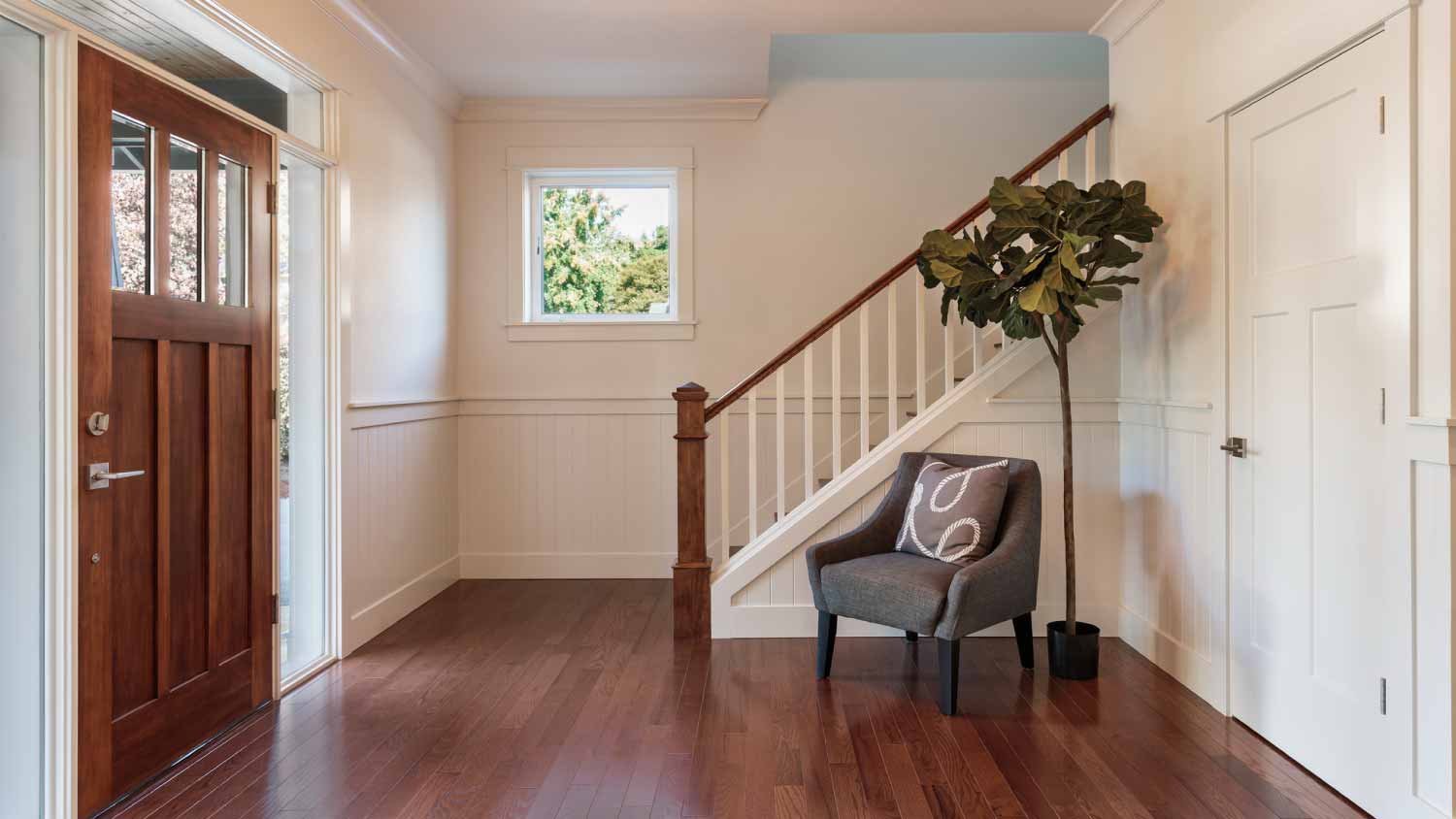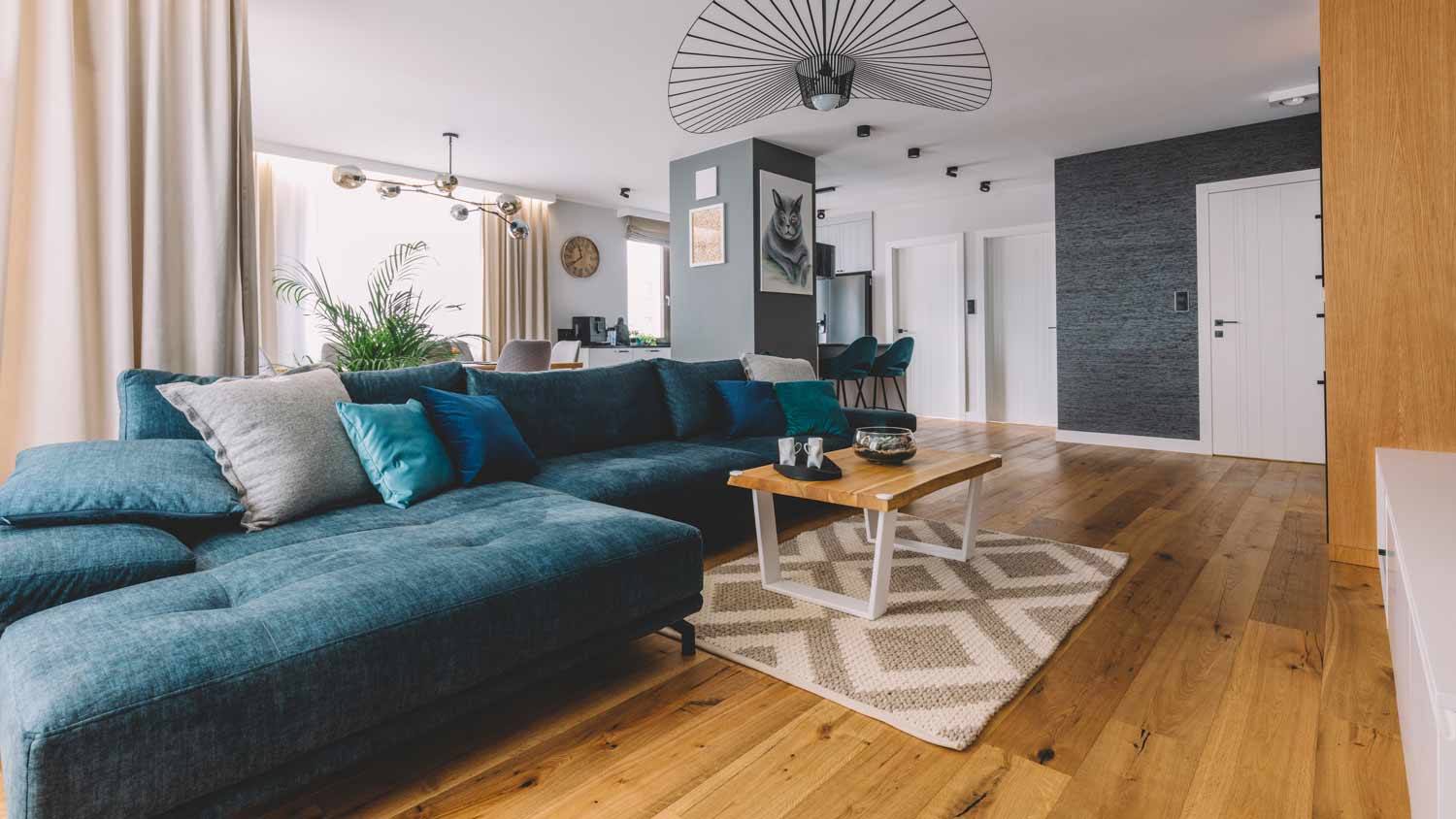Laminate vs. Vinyl Flooring: Pros, Cons, Costs, and More
Comparing two attractive flooring options to determine which is best for your home


Laminate and vinyl flooring can mimic the appearance of hardwood.
Both are durable, low-maintenance, and easy to install.
Average costs range from $1–$7, depending on plank thickness.
From active kids to furry friends, busy lifestyles mean homeowners are looking for durable yet stylish floors that can keep up. With this in mind, laminate and vinyl flooring are popular options—affordable alternatives to some of the most sought-after wood and tile looks on the market today.
To determine which one is right for your home between these two synthetic surfaces, we’ll cover all of the characteristics and differences that might help one or the other perform better in your space.
What Is Laminate Flooring?
Laminate flooring was one of the first synthetic alternatives to natural hardwood, and each plank has a high-density fiberboard core that’s made using natural wood byproducts. This natural composition reduces the environmental impact of laminate manufacturing. However, it also results in a product that is water-resistant but not fully waterproof.
Laminate planks tend to be 6 to 12 millimeters thick on average, lending a cushioned feel that’s comfortable enough underfoot to be installed in high-traffic living areas and hallways.

What Is Vinyl Flooring?
Vinyl floors are found in many forms, including sheet vinyl, LVP (luxury vinyl plank), LVT (luxury vinyl tile), WPC (wood plastic composite), and SPC (stone plastic composite). All feature a solid core made of 100% synthetic material. In most products, this allows for fully waterproof construction.
You’ll find vinyl that ranges from stiff and hard to resilient and comfortable, depending on the material used for the core. Most luxury vinyl planks and tiles average about 5 millimeters thick. Vinyl is ideal flooring for rooms that get wet, such as bathrooms, kitchens, laundry rooms, and mudrooms.
"We prefer to use luxury vinyl plank flooring in most of our bathroom remodels," says Bill Samuel, licensed general contractor and owner of Blue Ladder Development in Chicago, IL. "It’s durable and most options are 100% waterproof as well."

Comparing Laminate and Vinyl Flooring: What’s the Difference?
At first glance, laminate and vinyl flooring may look a lot alike. Both are hard surfaces designed to look like natural materials, such as solid hardwood, stone, or ceramic tile. Each also consists of several layers of synthetic material, including a stabilizing backing layer, a realistic photographic layer, and surface wear layers that protect from scratches and stains.
So what sets these two categories apart? The difference is primarily in the core of each product. Vinyl flooring is a fully waterproof option best suited for rooms that get wet or homes with pets, while laminate tends to be more comfortable underfoot and offers more affordable high-end looks.
Even once you’re familiar with the key characteristics of both laminate and vinyl flooring, it can still be tough to know which is the best choice for your home improvement project. To help you decide, we’ve broken down how each floor performs across a variety of metrics.
Appearance

Both laminate and vinyl can visually mimic any type of wood, tile, or stone. You can choose from a wide variety of style options, right down to the wood species, and match your floors with any decor style or color palette.
Both types of flooring also offer realistic, three-dimensional embossing to mimic natural wood grain textures and stylistic choices, such as hand-scraping, distressed wood, and more. These textures look and feel best on thicker planks, giving laminate the edge, unless you choose a vinyl product with a thicker core.
Life Span
When investing in new flooring, you want to choose a surface that will still look new for many years after installation. Both laminate and vinyl are highly durable, with lasting laminate lasting between 10 to 30 years and vinyl lasting 10 to 25 years with proper care and maintenance. They’re also both resistant to scratches and stains, thanks to their respective top layers. When it comes down to it, vinyl and laminate are about equal in durability.
Remember that you cannot repair or refinish laminate flooring like you can with traditional hardwood. And vinyl, while waterproof, can wear over time. If you’re wondering whether it’s time to replace your floor, keep an eye out for signs like creaking, gaps, mold, water damage, and pieces peeling up.
Water Resistance
The key difference between vinyl and laminate flooring, again, is that laminate is not waterproof. If moisture seeps into the seams between planks, it will experience irreparable swelling and warping. We don’t recommend installing laminate floors in rooms that tend to have a lot of moisture, such as bathrooms, kitchens, and basements. If you want to give your bathroom or kitchen floors a makeover, vinyl is the winner here.
Heat Resistance
If you’re looking for flooring that will withstand extreme heat, neither laminate nor vinyl is ideal (tile and engineered hardwood would better serve that purpose). If you don’t turn the dial too high (not above 82 degrees Fahrenheit), laminate and vinyl can work with radiant flooring, so you’re in luck if your heart is set on a warm floor during the winter.
In general, vinyl plank flooring won’t hold up to temperatures above 85 degrees or malfunctioning appliances like a fridge. Laminate flooring can contract in cold temperatures and expand in warm temperatures. If pushed too far, it can start to bubble or lift. The final takeaway is that neither option is ideal if you need your flooring to withstand extreme temperatures.
Installation
One major appeal of both laminate and vinyl flooring is their easy installation.
Laminate typically uses a click-and-lock method where planks snap together with adjoining tongues and grooves along their edges. Most laminate is installed as a floating floor over existing flooring or subflooring. A regular table saw can be used to cut planks to fit wherever they need to go.
Vinyl plank flooring is similar, but offers more variety for installation methods depending on the product you choose. Sheet vinyl, for example, is a more complex glue-down product that requires adhesives and precise cutting. Luxury vinyl plank and tile are more often click-and-lock floating floors that can be cut with normal saws or utility knives.
Click-and-lock floors are very DIY-friendly, but unless you have prior experience, you can hire a local professional flooring installer to ensure the job is done well. Improperly installed floors of any type can lead to damage and poor performance down the road.
Maintenance
Both laminate and vinyl flooring are fairly easy to maintain, only requiring regular cleaning.
With laminate, it’s best to only use manufacturer-approved cleaning products to preserve its longevity, as harsh cleaners can strip the protective coating. Avoid using scouring and scrubby cleaning pads, which can scratch up the floor. Also, clean up water puddles as soon as possible since laminate isn’t waterproof.
For vinyl flooring, you can use dish soap solutions or vinegar solutions to safely clean it. If you prefer commercial cleaners, use those that are labeled "safe for vinyl." Ammonia- or solvent-based cleaners can damage the protective coating.
Sustainability
Understanding that laminate and vinyl flooring are synthetic, plastic surface layers, they’re not made from natural materials that can decompose or be recycled.
According to the Environmental Working Group, these types of synthetic floorings may contain harmful materials like PVC and emit volatile organic compounds (VOCs), chemicals that can pollute the air in your home.
Costs
When it comes to new flooring options, one of the biggest deciding factors for many homeowners is budget. You’ll find that both vinyl and laminate are roughly comparable in price and much more affordable flooring alternatives to natural solid and engineered hardwood flooring.
Laminate flooring costs start at around $1 per square foot for 7-millimeter planks, scaling up to $5 per square foot for thicker 12-millimeter planks. Vinyl flooring tends to be more expensive than laminate, but its performance and price varies dramatically based on the type of vinyl product you choose.
Simple glue-down vinyl sheet looks and feels less like natural wood or tile, but is also the most affordable option at $1 per square foot. Prices for luxury vinyl tile or vinyl plank flooring can range from $2.50 to $7 per square foot, depending on the thickness of the wear layer.
Pets
Floors tend to experience more wear and tear if you have pets, especially dogs or cats. From scratches and water dishes to house-training accidents, you need floors that can handle the day-to-day wear from your furry friends.
Laminate and vinyl flooring are both resistant to scratches. Pet hair and dander are easy to sweep off the surface of each type. However, since laminate is not 100% waterproof, vinyl flooring is deemed the best flooring protection from pets. Just be sure to choose a vinyl product with a thick wear layer.
Resale Value/ROI
Floor renovations with these two flooring types can help increase the home value, especially if you’re swapping out pre-existing laminate or vinyl. On the other hand, neither have the high-value ROI of regular hardwood flooring or natural stone flooring.
How to Choose the Best Flooring

Laminate and vinyl floors offer many similar features, so the decision you make between them will likely come down to your budget and the styles you prefer. As you shop around and compare your options, you may also want to see how vinyl and laminate stack up against other flooring options.
Both vinyl and laminate are attractive and affordable alternatives to natural materials like hardwood flooring. But despite being more expensive and challenging to install, hardwood has a greater resale value and the ability to refinish the surface over time.
Use the chart below to help determine whether laminate or vinyl is the best flooring for your home. Once you settle on a type, you can consult a laminate or local vinyl floor installer to review a variety of options.

.jpg?impolicy=leadImage)



- Everything You Need to Know About Laminate Flooring
- How Long Does Laminate Flooring Last? What to Know Before Installing or Replacing Your Flooring
- Can You Paint Laminate Flooring for a Home Upgrade? Don’t Start Until You Read This
- How to Dispose of Laminate Flooring Quickly and Safely
- Top 15 Tips for Installing Laminate Flooring Like a Pro
- The Differences Between Laminate and Hardwood Flooring, Explained
- 6 Inexpensive Flooring Options That Look Good and Save You Money
- 5 of the Best Choices for Vinyl Flooring for Kitchens
- 11 Types of Flooring to Consider for Your Home
- How to Acclimate Laminate Flooring for the Best Results










